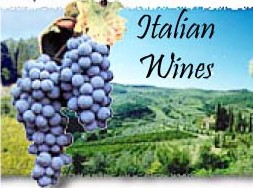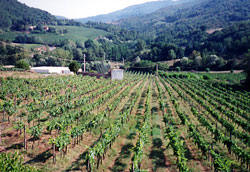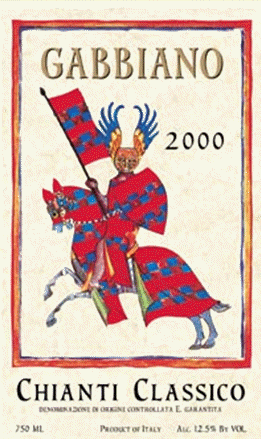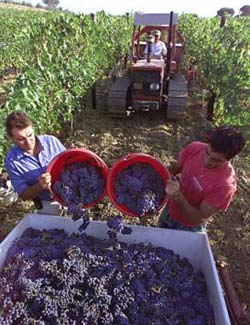Tuscany Wine Terms
 Perhaps
no region of the world personifies the warmth and graciousness of good food and
great wine more completely than
Perhaps
no region of the world personifies the warmth and graciousness of good food and
great wine more completely than
Throughout its colorful history,
Tuscany's museums, sights, and
edible delights are unsurpassed. A special mystique and light envelops this
region of Italy, distinct from anywhere else in
What is Chianti?
There are seven sub zones within
Chianti is produced from a blend
of Sangiovese, Cabernet Sauvignon, and other non traditional varietals.
Chianti Classico must be 80% Sangiovese and might have some white grapes
in the blend. It is normally aged
for 18-24 months in oak. Chianti
Classico Riserva is the top quality Chianti, has no white grapes, and is aged in
oak for 3 years or more.
What is Sangiovese?
Sangiovese is the prominent grape of many Tuscan wines, including Chianti,
Brunello di Montalcino, Carmignano, Vino Nobile di Montepulciano, and other
barrel-aged wines. The Tuscan winemaking style calls for Sangiovese to be
blended with other varieties, but it is the Sangiovese that gives the character,
perfume, and structure to the wines.
What is DOCG?
Denominazione di origine controllata e garantita (DOCG) stands for a
"controlled and guaranteed appellation of origin." This designation
controls the quality of the wine under established government standards that
define the region, grape varieties, per-acre yields, aging requirements, and
other factors. There is also a
lesser designation known as DOC, with fewer restrictions and control.
Reading a Typical
Chianti Label
In general, there are as many Chianti label designs as there are wineries. Each label design is unique to the particular winery, but all include essential information about the wine, as required by Italian governmental and U.S. Federal regulations.
 For
example, Castello di
Gabbiano's wine labels are not only colorful and informative but also easy to
understand. Castello di Gabbiano makes three types of Chianti, one
of which Riserva, is estate grown and bottled. The other two are Chianti
Classico and Chainti DOCG. All of the Gabbiano Chianti are classified as
DOCG, the highest quality standard the Italian government awards to wines from
recognized winegrowing zones.
For
example, Castello di
Gabbiano's wine labels are not only colorful and informative but also easy to
understand. Castello di Gabbiano makes three types of Chianti, one
of which Riserva, is estate grown and bottled. The other two are Chianti
Classico and Chainti DOCG. All of the Gabbiano Chianti are classified as
DOCG, the highest quality standard the Italian government awards to wines from
recognized winegrowing zones.
The
fresco depicted the Cavaliere with a group of riders that were in a joust or
parade and is also symbolic of the warrior knights that protected the landowners
from invasion in the Middle Ages. Unfortunately, the fresco was destroyed during
World War II when bombing in the area crumbled that portion of the castle wall.
The
image of Castello di Gabbiano's Cavaliere
was preserved in an original preliminary drawing of the fresco. This
centuries-old drawing, called a sinopia, has an elegant design attributed
to the Florentine artistic tradition.
Typically at the bottom of the
label are the bottle size (contents in ML), usually a vineyard location or site
of production, plus the alcohol content. Also
shown might the designation of DOC or DOCG to indicate the approved government
guarantee of the wines origin and vinification standards.
A to Z
Guide to Tuscan Wine
 Tuscany
is a cornucopia of diverse wines, and Chianti is the Heart & Soul of
Tuscany
is a cornucopia of diverse wines, and Chianti is the Heart & Soul of
Azienda
agricola (AH ZYEHN DAH. AH GREE KOH LAH)
Wine
Estate
Amàbile
(AH MAH BEE LEH)
Sweet
Amaro
(AH MAH ROH)
Bitter
Annata
(AHN NAH TAH)
Vintage date
Barrique
(BAHR REE KEH )
50- to 60- gallon oak barrel often used to age non-traditional wines
Bianco (BEE YAHN KOH)
White
Botte
(BOHT TEH)
Traditional 500-gallon wood barrel for aging wine
Bottìglia
/ Bottiglierìa (BOHT TEE LYAH / BOHT TEE LYEH REE AH)
Bottle / Wine shop
Brunello
di Montalcino (BROO NEHL LOH DEE MOHN TAHL CHEE NOH)
Full-bodied, complex red wine; intense herbal-cherry flavors. Always 100%
Sangiovese Grosso grapes (called Brunello by locals) from Montalcino, south of
Caratello
(KAHR AH TEHL LOH)
20- to 25-gallon wood barrel used to age wine, such as Vin Santo.
Carmignano
(CAHR MEE NYAH NOH)
Intense, full-bodied red wine. Cherry flavor. From hills northwest
of
Cavatappi
(KAH
Corkscrew
Chianti
(KYAHN TEE)
One of Italy’s most famous wine regions with seven zones. Covers most of
central
DOC
(Denominazione di Origine Controllata)
The Italian government’s first wine quality codes—dictate geographic origin,
grapes varieties, and vineyard and winemaking practices.
DOCG
(Denominazione di Origine Controllata Garantita)
Highest wine rating with the most stringent codes—specify geographic origin,
grape varieties, and vineyard and winemaking practices. Wines approved by
government tasters.
Dolce
(DOHL CHECH)
Sweet
Enoteca
(EH NOH TEH KAH)
Wine shop
Fattoria
(FAHT TOH REE AH)
Estate, farm.
Frizzante
(FREE TZAHN THE)
Slightly sparkling
Galestro
(GAH LEHS TROH)
Simple, easy drinking white wine from Chianti area.
Grappa
(GRAHP PAH)
Distilled drink made from grape skins, seeds and stems leftover from winemaking.
Sold in bottles of all shapes, sizes and colors. A specialty of
IGT (Indicazione
Geografica Tipica)
Newest government category often assigned to non-traditional wines, such as,
“Super Tuscans”. Varietal, vintage and vineyard can be listed on the
label.
Moscadello
di Montalcino (MOHS KAH DEHL LOH.
Sweet
white wine of
Passito
(PAHS SEE TOH)
A method of making wine using grapes that are hung to dry or dried on mats.
Pomino
Bianco (POH MEE NOH. BYAHN KOH)
Dry, full-bodied rich white wine, usually oak-aged. Blend of Pinot Blanc,
Sauvignon Blanc, Pinot Grigio and Chardonnay grapes—grown just east of
Pomino
Rosso (POH MEE NOH. ROHS SOH)
A red
wine made of Sangiovese, Merlot, cabernet Sauvignon, and Pinot Noir grapes.
Produced in the hills just east of
Rosato
/ Rosso (ROH SAH TOH / ROHS SOH)
Rosé / red
Sassicaia
(SAHS SEE KAHY AH)
Famous, expensive red wine from Bolheri on
Secco
(SEHK KOH)
Dry
Spumante
(SPOO MAHN THE)
Sparkling
Super
Tuscan
Non-traditional Tuscan wines; often a winery’s best wine. Expensive.
Varietals vary—Sangiovese, Merlot, Syah, and Cabernet Sauvignon are popular
(blends to 100%). Often oak-aged.
Vendemmia
(VEHN DEHM MYAH)
Vintage
Vernaccia
di San Gimignano (VEHR NAHCH CHYAH.
Dry white wine;rich herbal flavors. Vernaccia grapes from San Gimignano.
Vino da
Tavola (VEE NOH DAH. TAH VOH LAH)
Lowest wine category; cannot list region, grape varietal or vintage on label.
Vino
Nobile di Montepulciano (VEE NOH. NOH BEE LEH.
Full-bodied red wine. Sangiovese grapes blended with other varietals.
Similar to Chianti, but more complex.
Vin
Santo (VEEN. SAHN TOH)
Dessert wine
A
to Z Guide to Tuscan Food
Tuscan
food is simple and delicious. Typical Herbs are Rosemary, Sage, Oregano,
and Basil. Italians love bread soup (ribollita) and salad (panzanella),
and are addicted to grilled bread with garlic (bruschette). The finest
olive oil in
Agnello
(AH NYEHL LOH)
Lamb, a Tuscan favorite
Al
forno (AHL FOHR NOH)
Baked
Ànatra
(AH NAH TRAH)
Duck. Popular in meat sauce in
Eel. In
Arista (AH REES TAH)
Roasted pork loin, seasoned with rosemary and garlic.
Arrosto
(AHR ROHS TOH)
Roasted
Arrabbiata
- all’ arrabbiata (AHL LAHR RAHB BEE YAH TAH)
“Angry” tomato pasta sauce with olive oil and hot red peppers
Bistecca
alla fiorentina (BEES TEHK KAH. AHL LAH. FYOH REHN TEE NAH)
Bollito
(BOHL LEE TOH)
Boiled or stewed
Brace
– alla brace (AHL LAH. BRAH CHEH)
Grilled over charcoal
Braciola
/ bracioletta (BRAH CHYOH LAH / BRAH CHYOH LEHT TAH)
Chop / small slice of meat
Brasato
(BRAH SAH TOH)
Braised beef; cooked in red wine
Bruschette
(BROOS SKEHT TAH)
Cantucci
(CAHN TOOCH CHEE)
Tuscan almond cookies, also called Biscotti di Prato. Served with Vin Santo wine
Capra
(KAH PRAH)
Goat
Carciofi
(KAHR CHYOH FEE)
Artichokes. An antipasto or pasta sauce in
Castagnaccio
(CAHS TAH NYACH CHYOH)
Popular Tuscan chestnut flour cake with raisins, nuts, and rosemary
Ceci (CHEEH
CHEE)
Garbanzo beans; Chick peas. Popular side dish in
Cinghiale
(CHEEN GYAH LEH)
Wild boar. A Tuscan favorite—in sauce (sugo di cinghiale), prosciutto,
salame and sausage
Coniglio
(KOH NEE LYOH)
Rabbit—One of
Costa /
costoletta / costarelli (KOHS TAH / KOHS TOH LEHT TAH / KOHS TAH REHL
LEE)
Chop /
Cutlet / Rib / spareribs. Costada di manzo is rib steak.
Meat cuts are very different from US cuts
Cozze
(KOH TSEH)
Mussels
Crespelle
(KREHS PEHL LEH)
Crepes
Crostata
(KROHS TAH TAH)
Cake / Pie with thin layer of fruit or jam
Fagiano
(FAH JAH NOH)
Pheasant—All game is popular in
Fagioli
(FAH JOH LEE)
Beans—very popular side dish or soup. Fagioli all’uccelletto, a Tuscan
bean dish, is seasoned with sage, garlic and tomatoes.
Fegato
/ Fegatini (FEH GAH TOH / FEH GAH TEE NEE)
Liver / chicken liver—In
Fatto
in casa (FAHT TOH. EEN. CAH ZAH)
Homemade
Fetta
di / fettina (FEHT TAH. DEE / FEHT TEE NAH)
Slice of / thin slice
Fettunta
(FEHT TOON TAH)
Toasted slice of Tuscan bread with olive oil
Finòcchio
(FEE NOHK YOH)
Fresh fennel—cherry like with anise flavor
Finocchiona
(FEE NOHK KYOH NAH)
Tuscan salame with fennel seeds
Formaggio
(FOHR MAHJ JOH)
Cheese—Pecorino isTuscany’s famous cheese
Funghi (FOON GHEE)
Mushrooms, usually porcini
Gàmberi
/ gamberétto / gamberoni (GAHM BEH REE / GAHN BEH REHT TOH / GAHN BEH
ROH NEE)
Prawns / crayfish / large prawns
Ghiótta
– alla ghiótta (AHL LAH. GYOT TAH)
Basted
with seasonings while grilling
Granchio
(GRAHN KYOH)
Crab
Griglia—alla
griglia (AHL LAH. GREE LYAH)
Grilled over charcoal
Lèpre (LEH
PREH)
Hare or rabbit—One of the most popular meats in
Lésso (LEHS
SOH)
Boiled
Lombata
(LOHM BAH TAH)
Loin
Manzo
(MAHN ZOH)
Beef
Maiale
(MAHY AH LEH)
Pork
Milza
(MEEL ZAH)
Spleen—Often combined with liver as a topping for crostini
Olio
d’oliva (OH LYOH. DOH LEE
Olive oil. In
a condiment, drizzled over soup and pasta, for example. Extra virgin,
from the first pressing, is the finest—Best purchased in the fall, just after
pressing
Panforte
(PAHN FOHR THE)
A dense sweet cake from
Panzanella
(PAHN ZAH NEHL LAH)
This Tuscan first-course dish is made of bread, tomatoes, onions, basil and
olive oil.
Pappa
col pomodoro (PAH PAH. COHL. POH MOH DOH ROH)
A Tuscan tomato-bread soup
Papparadelle
(PAHP PAHR AH DEHL LEH)
Very Tuscan—1-inch wide, flat pasta—Often served with wild boar (sugo di
cinghiale), hare (sugo di leper) or duck (sugo di ànatra) sauce
Pecorino
(PEH KOH REE NOH)
A Tuscan sheep’s milk cheese, fresh (fresca) or aged. Best is from
Pienza
Penne (PEHN
NEH)
Hollow, quill-shaped pasta, about 2-inches long
Petto
(PEHT TOH)
Breast, i.e. chicken
Piccione
(PEECH CHYOH NEH)
Squab
Pici
(PEE CHEE)
A round, but irregular, pasta like spaghetti, but much thicker and more
rustic—Very Tuscan
Pollo
(POHL LOH)
Chicken—Pollo alla diavola is
Polpo /
polipo (POHL POH / POH LEE POH)
Octopus. Polpetti are baby octopus
Prosciutto
(PROH SHOOT TOH)
‘crudo’ is air-dried ham, finer in texture and drier than cooked ham.
In
Ribolitta
(REE BOH LEET TAH)
Tuscan twice-boiled bread soup
Ricciarelli
(REECH CHYAH REHL LEE)
A chewy almond cookie from
Salsìccia
(SAHL SEECH CHAH)
Sausage
Sàlvia
(SAHL VYAH)
Sage, a favorite in
Soppressata
(SOHP PREHS SAH TAH)
Course Tuscan salame, like headcheese
Sugo
(SOO GOH)
Juice from meat or tomato sauce
Tagliatelle
(TAH LYAH TEHL LEH)
Long ⅛ inch wide noodles, similar to fettuccine
Tagliolini
/ tagliarini (TAH LYOH LEE NEE / TAH LYAH REE NEE)
1/16- inch wide noodles
Tortelloni
/ tortelli (TOHR TEHL LOH NEE / TOHR TEHL LEE)
Large stuffed pasta / stuffed pasta similar to ravioli
Umido-
in umido (EEN. OO MEE DOH)
Braised; cooked in liquid
Vitello
(VEE TEHL LOH)
Veal
Vóngole
(VOHN GOH LEH)
Clams
Zucca
(ZOOK KAH)
Similar to pumpkin; popular in ravioli or tortelli
Zuppa
(ZOOP PAH)
Soup—Minestra also means soup or first course.

Information and tips for finding end enjoying everyday wines from Europe and other major wine regions:
Search the Blogs
Copyright WineNews.com 2009

